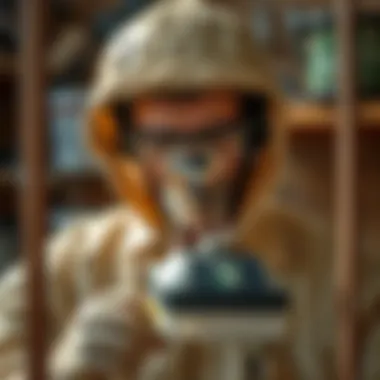Advanced Devices for Effective Mouse Control


Intro
When it comes to managing unwanted rodent guests, techniques can range from traditional traps to high-tech ultrasound devices. Understanding how to tackle the issue of mice infestations is crucial for homeowners and those managing commercial spaces. This article aims to shed light on innovative devices designed specifically for controlling mice populations. It's not just about repelling these small creatures; it's about creating a strategy that is effective, humane, and environmentally friendly.
Understanding the Pest
Identification
Identifying a mouse infestation starts with recognizing its presence. These nighttime nibblers leave subtle signs behind: droppings, gnaw marks, and nesting materials like shredded paper or fabric. Adult mice typically measure about 2.5 to 4 inches long, with their tails adding another 3 to 4 inches. They often scurry along walls, as they feel more secure in tight spaces. Early identification can save a lot of hassle down the line, as it can help to prevent a full-blown infestation.
Life Cycle
Mice reproduce at an alarming rate. A female house mouse can give birth to up to twelve pups in a single litter, and she can mate again almost immediately after giving birth. In ideal conditions, a pair of mice can generate hundreds of offspring within a year. Understanding this rapid life cycle underscores the necessity for quick action when signs of infestation are noticed. Their lifecycle typically spans about two years, but a significant portion of their population may not survive long due to predators and environmental factors.
Pest Prevention Strategies
Environment Modification
The best offense is often a good defense. Modifying the environment can significantly deter mice from setting up shop in your home. This involves eliminating food sources and hiding spots. Here are some steps:
- Seal up cracks and crevices: Use materials like silicone or steel wool to close any holes that could serve as entry points.
- Store food properly: Keep pantry items in airtight containers. Mice have a keen sense of smell and can sniff out even the smallest crumbs.
- Declutter your spaces: Less clutter means fewer hiding places. Regular cleaning can help keep them at bay.
Physical Barriers
Physical barriers are another effective method for preventing mice access. Screens, covers, and traps can serve as a frontline defense.
- Door sweeps and weather stripping: These features can block gaps beneath doors and windows.
- Mesh barriers: Use these materials around vents and ducts, as mice can squeeze through the tiniest gaps.
Control Methods
Chemical Control
While many homeowners prefer non-chemical methods, sometimes chemical control is necessary. Rodenticides can be effective but come with risks. It’s essential to consider their environmental impact. This includes potential harm to pets and other wildlife. When using any chemical control, adhering to manufacturer guidelines is crucial to ensure safety and effectiveness.
Biological Control
Biological control methods employ natural predators to manage rodent populations. Cats have historically been used for this purpose, and some studies suggest that the presence of a cat can significantly reduce mouse activity. Additionally, certain strains of bacteria and viruses specifically affecting rodents are being researched for their potential as a biological control method. This avenue, however, is still being explored and should be approached cautiously.
Understanding the balance between control and empathy is essential. As we devise strategies against infestations, taking care of the environment and the creatures we share it with must be a priority.
For further information, you can check out resources such as Wikipedia on Rodents, Britannica, and community tips on Reddit.
Also visit government sites for pest control regulations, such as CDC.gov for public health insights.
Intro to Mouse Control
Mice aren’t just cute little creatures you see in cartoons; they can turn your home or business into a battleground if left unchecked. Understanding how to control mice populations is not just important; it’s essential for maintaining a clean and healthy environment. With every corner turned, a mouse can potentially leave behind droppings that may spread diseases, or even chew through electrical wiring, risking fire hazards. Therefore, knowing effective methods to manage and repel these pests is vital.
In this article, we’ll dive into innovative devices designed to chase these critters away from your spaces, exploring various types and their mechanics. From ultrasonic devices that can drive mice away with sound they cannot tolerate to natural methods that rely on scents and homemade solutions, we will dissect the benefits and downsides of each method.
Here’s why understanding mouse control matters:
- Health Risks: Mice can carry harmful bacteria and viruses, posing serious health risks to your family or customers. By controlling their population, you reduce the chances of diseases spreading.
- Structural Damage: They are known for their destructive habits. Mice can gnaw on wires, insulation, and even wood, potentially leading to costly repairs. Keeping them at bay preserves the integrity of your property.
- Peace of Mind: Knowing that your home or business is free from unwanted guests allows you to focus on what truly matters. No one wants to hear the pitter-patter of tiny feet in the night or discover droppings around their food.
By investigating the various devices and techniques available today, you'll be better equipped to address any mouse problems effectively, prioritizing both efficiency and safety.
"Prevention is better than cure." – This age-old proverb rings particularly true when it comes to mouse control. Being proactive can save you a lot of headaches down the line.
Let’s dig deeper by first understanding how mice behave. This will enable us not only to understand why they invade our spaces but also how we can repel them successfully.
Types of Devices to Repel Mice
Controlling mice populations effectively requires a blend of knowledge and practical applications. Various devices are designed to combat this pest issue, each serving different needs and preferences. The significance of understanding these devices lies in their distinct characteristics and the specific contexts where they shine.
By exploring different methods of controlling mice, such as ultrasonic devices, natural repellents, and traps, homeowners can choose solutions that suit their spaces and ethical views. Every method has its pros and cons, so assessing their utility not only affects pest management but also the overall living environment.
Ultrasonic Pest Repellers
How Ultrasonic Devices Work
Ultrasonic pest repellers operate on a simple principle—they emit a high-frequency sound that's inaudible to humans but uncomfortable for mice. Most devices typically produce sound waves between 20 kHz to 65 kHz, creating an environment that mice find unpleasant. This method aims to disrupt their communication and navigation, pushing them away from the area where the device is situated.
One critical aspect of ultrasonic devices is their reach; they can cover a substantial area, making them a popular choice for larger spaces like warehouses or open-plan homes. However, furniture and walls can dampen the effectiveness of the sound waves.
Advantages include:
- Non-lethal approach, maintaining an ethical stance.
- Easy plug-and-play installation without needing chemicals.
- Low maintenance and continuous operation.


On the downside, some research suggests its inconsistent effectiveness across varied environments.
Advantages of Using Ultrasonic Repellers
The primary appeal of ultrasonic repellers lies in their eco-friendliness. They present a solution that doesn't involve toxic substances, making them ideal for households with children and pets. Their low power consumption is another plus—users can run them for long periods at a fraction of the cost of other solutions.
Moreover, many devices come with additional features like LED lights that can serve a dual purpose for household security. However, cautious observations from some users indicate that a small percentage of mice might become accustomed to the sound over time, potentially diminishing effectiveness.
Limitations of Ultrasonic Technology
While the idea behind ultrasonic repellents is appealing, they are not a one-size-fits-all solution. Several factor can impact their success. For starters, if a home has an extensive floor plan or many obstacles, the efficacy may wane quickly. Furthermore, these devices often cannot reach areas of high mouse activity as long as sound waves can’t permeate walls.
Another limitation revolves around the range of frequencies; some electronic devices, like televisions or radios, may interfere with the repeller's operation. Thus, users must understand the specifics of their living conditions to maximize the benefits of these devices, despite their overall appeal and convenience.
Natural Repellents
Essential Oils and Their Efficacy
Natural repellents have gained momentum for those seeking a more organic approach to pest control. Essential oils like peppermint, cinnamon, and eucalyptus are widely touted for their rodent-repelling properties. The dominant theory is that the strong scents confuse mice and deter them from settling in, as they are sensitive to smells.
A notable advantage of using essential oils is their safety. Unlike chemical pesticides, essential oils are generally safer for household environments. Notably, the allure of DIY pest solutions using these oils can save on costs while boosting eco-conscious values. However, efficacy can vary greatly depending on the oil concentration and the method of application. Some users find oils must be reapplied frequently to maintain effectiveness, which can become labor-intensive.
Homemade Solutions and Recipes
Creating homemade pest solutions usually taps into common household ingredients, which makes it easy and cost-effective. A simple mixture might include water, vinegar, and essential oils in a spray bottle. Spraying this at entry points can form a barrier that mice might avoid.
The beauty of this approach lies in customization—homeowners can adapt recipes based on what works best for their areas. Moreover, using readily available ingredients adds to the convenience, keeping the budget in check. However, some users may find these solutions less potent compared to commercial alternatives.
Environmental Benefits of Natural Repellents
Natural repellents often hold environmental advantages over synthetic options. Their biodegradability and minimal ecological footprint make them increasingly attractive to eco-conscious consumers.
Choosing plants with pest-repellent qualities for garden landscaping or using essential oils minimizes toxic runoff, positively impacting surrounding wildlife. Furthermore, employing these methods not only helps in pest control but boosts biodiversity in local ecosystems, allowing nature to take a larger role in management, though some preparations may require repeated applications to maintain effectiveness.
Trapping Mechanisms
Catch and Release Traps
Catch and release traps symbolize a humane approach to pest management. Users set traps that capture mice unharmed, allowing for relocation away from the home. Their effectiveness relies on strategic placement near known pathways of mouse traffic.
A unique feature of these traps is the ability to monitor activity without killing, appealing to those who prefer ethical pest management methods. However, the trade-off is the responsibility of ensuring the captured mice are released far enough away from homes to prevent return. Users must also commit to checking traps regularly to prevent undue stress on the captured animals.
Electronics in Modern Traps
Modern traps have advanced significantly, integrating electronic components for increased efficiency. These traps often utilize sensors to detect mouse presence and zap them with a quick electric shock, leading to a swift end. The efficiency of these devices provides a cleaner and quicker alternative to traditional methods.
The advantage here lies in the ease of use and clean disposal; homeowners do not have to deal with snapping traps and potential mess. On the flip side, these devices are often more expensive upfront and require regular battery replacements, which could deter some users seeking simple solutions.
Selecting the Right Trap for Specific Needs
Choosing the right trap involves understanding the specific circumstances of the infestation. A small living space may benefit from traditional snap traps, while larger areas might be better served by more sophisticated electronic traps or catch-and-release options.
Users should assess factors such as mouse activity levels, the environment, and ethical preferences. Some traps may be more effective in specific settings but less so in others. Therefore, conducting due diligence can maximize effectiveness and satisfaction in the long run.
In summary, selecting from the myriad available devices requires careful consideration of factors ranging from effectiveness to ethical implications. By understanding the nuances among options, homeowners can enhance their efforts in maintaining environments that are not only mice-free but also healthy and conducive to living.
Technological Innovations in Pest Control
The realm of pest control has significantly evolved with the incorporation of technological advancements. Innovative devices not only enhance the efficiency of managing pests but also provide solutions that are more aligned with modern lifestyles and concerns about environmental impact. Embracing technology in pest management isn't just a trend; it represents a deeper understanding of ecological balance and the need for precise methods to handle infestations without excessive harm to the environment.
As we navigate through these novel applications, the integration of smart devices, biometric solutions, and their respective contributions become apparent in establishing a more effective approach toward controlling mouse populations.
Smart Devices for Monitoring
Integration with Home Automation Systems
Integrating pest control devices with home automation systems is becoming a common practice. This connection allows homeowners to manage mouse repellent devices seamlessly alongside their other smart home products. The key characteristic here is connectivity. Such systems can be programmed to send alerts when mice enter certain areas, which provides real-time intelligence and allows for immediate responses. The convenience of this integration makes it a popular choice among tech-savvy individuals.
Smart home automation extends beyond simple notifications, offering remote control and configurations to manage devices even when homeowners are away. However, there can be drawbacks, primarily dependent on reliable Wi-Fi connections to maintain functionality. In scenarios where connectivity falters, users may find themselves without vital information about potential infestations.
Benefits of Real-Time Tracking
Real-time tracking is a pivotal aspect of modern pest control devices. This feature empowers homeowners to monitor mouse movements and behaviors continuously, enhancing the overall approach to pest management. One significant benefit is the ability to observe patterns that would have otherwise gone unnoticed.
This provides a clear overview of the problem at hand, allowing for targeted solutions. Real-time data can lead to more effective strategies in repelling or capturing unwanted rodents, thus reducing reliance on potentially harmful chemicals. Despite these advantages, the complexity involved in interpreting this data might deter some users who prefer straightforward solutions.


User-Friendly Features and Interfaces
User-friendly features are essential for a successful implementation of any smart device. Intuitive interfaces allow homeowners to navigate settings, receive notifications, and modify preferences without steep learning curves. This characteristic greatly contributes to the efficacy of innovative pest control solutions.
Many modern interfaces are designed with simplicity in mind, ensuring that even individuals who aren’t technically inclined can manage their devices effectively. This encourages more people to adopt technological solutions to pest management. However, frequent updates and software changes can sometimes introduce complications, making it essential for manufacturers to prioritize stability alongside innovation.
Biometric Solutions
How Biometric Systems Can Repel Mice
Biometric systems reflect a pioneering approach to pest control, harnessing advanced technology to identify threats, such as mice, without reliance on traps or poisons. This concept revolves around detecting unique biological markers—whether it's a sound frequency particular to mice or their specific movements. The noteworthy aspect of this technology lies in its design to create an environment that naturally deters rodents.
The effectiveness of these systems appeals to homeowners seeking non-lethal options to control rodent populations. However, some may raise concerns over the cost and scalability of such technology in residential settings.
Ethical Considerations
While employing biometric systems can be seen as humane, ethical considerations must not be overlooked. There’s an ongoing dialogue surrounding the implications of using advanced technologies for pest control, primarily focused on the impact on local ecosystems. Important too is how these systems affect non-target species, as they might repel beneficial creatures along with nuisances.
Supporting ethical pest management necessitates balancing innovation with ecological awareness. As these discussions unfold, clarity of intent and scrutinizing our approaches to intervention will guide the evolution of pest control methods.
Cost-Benefit Analysis
A thorough cost-benefit analysis informs homeowners about the viability of investing in biometric pest control solutions. Analyzing metrics like purchase price, installation costs, and ongoing maintenance against potential savings from reduced pest damage leads to a clearer understanding of value. This analysis often reveals that while initial investments may be high, long-term savings in repairs and product replacements can justify the expense.
Ultimately, dynamic technologies are breaking ground in pest management, granting homeowners better tools to build a sustainable strategy against rodent invasions. Continual improvements and focus on usability are crucial aspects that pave the way for innovation in this field.
"Incorporating technology into pest control isn't just about fighting a nuisance; it's about reshaping our futures with smarter, sustainable solutions."
By being informed of current innovations, homeowners are better equipped to tackle mouse populations effectively and responsibly.
Environmental Considerations
Controlling mice populations isn’t just about effectiveness; it's also about doing so in a way that respects our planet. Environmental considerations are crucial in this discourse as they ensure pest management strategies are sustainable, minimizing their impact on ecosystems. As society becomes increasingly aware of ecological consequences, it’s clear that the tools and methods we choose should not only address the problem but also harmonize with nature. Taking a closer look at this subject reveals significant insights that can influence pest control strategies moving forward.
Eco-Friendly Pest Management
Harmonizing Technology and Nature
When it comes to harmonizing technology and nature, the focus is to blend innovative devices with environmentally friendly practices. Instead of heavy reliance on toxic pesticides, this approach seeks to integrate smart devices that use natural repellents or humane traps. The key characteristic here is the ability to minimize disturbance to local wildlife while keeping homes free of rodent intruders. This positioning makes it a popular choice for many families looking for humane and effective solutions.
One unique feature of this method is the use of smart monitoring devices that alert homeowners when mice are present, without causing harm to other creatures. This is beneficial as it reduces potential harm to non-target species, allowing pest control to be conducted in a more responsible manner. However, a downside may include the initial cost of such technology, which can require a more significant investment upfront.
Biodiversity and Pest Control
Biodiversity is another critical aspect in the realm of pest control. A strategy that incorporates diverse methods often proves to be more effective. By understanding the dynamics of local ecosystems, homeowners can better tailor their pest management practices. A notable characteristic of this method is its potential to restore ecological balance. Thus, introducing predators or utilizing traps designed for specific rodents preserves non-target species in the area.
Among the unique features of biodiversity-focused pest control is the increased resilience against future infestations. More diversified environments are less likely to support large rodent populations, as natural checks and balances come into play. Yet, this doesn’t come without challenges; implementing strategies that account for biodiversity can require a deeper knowledge of local ecosystems, which may confound some homeowners.
Long-Term Environmental Impact
When addressing long-term environmental impact, it’s essential to consider not just immediate results, but the broader consequences of pest management strategies. A major concern here is the cumulative effect of using chemicals and non-recyclable materials that can degrade ecosystems over time. The understanding is that each action taken today can dictate the state of local populations and environments in the future.
A key advantage of adopting sustainable pest control devices is the emphasis on non-toxic materials and methods that yield a gentler footprint on both the planet and local wildlife. These can include biodegradable traps or the use of plant-based repellents. However, there might be trade-offs when it comes to effectiveness; sometimes, these eco-friendlier solutions may require more attention or frequent monitoring to keep rodents at bay compared to traditional methods.
Sustainability in Choice of Devices
Sustainability pushes the conversation further. A simple shift in perspective affects how devices for managing mice populations are designed and chosen. By considering sustainability at every step, from material selection to energy use, homeowners can contribute to broader efforts of environmental conservation.
Material Considerations for Devices
Material considerations play a pivotal role in the sustainability narrative. The rise of eco-friendly materials such as recycled plastics or sustainably sourced wood reflects a growing awareness of limiting waste and reducing carbon footprints. One notable characteristic is their durability, which can contribute to reducing the need for frequent replacements.
Households opting for these materials find them beneficial not only for their eco-conscious choice, but also for their long-lasting nature. However, sometimes the selection of such materials might come at a higher cost compared to traditional devices, thus requiring mindful purchasing decisions.
Energy Efficiency
When evaluating energy efficiency in pest control devices, it becomes clear that better energy practices result in lower bills and less environmental strain. Devices that consume less power or possess solar capabilities offer compelling advantages. The key feature of energy-efficient solutions is their ability to operate effectively with minimal energy consumption, which translates to sustained use without excessive energy expenses.
While some homeowners might find that investing in this technology initially requires a larger outlay, the long-term savings on electricity can be a substantial benefit. Yet, it’s crucial to assess whether the energy-efficient device will perform adequately in pest control tasks so that the investment pays off.
Disposal and Recycling Options
Finally, disposal and recycling options are increasingly relevant. Many pest control devices are made from materials that are not easily recyclable, which poses a challenge in reducing waste. The characteristic that stands out about modern devices is a push toward design for disassembly, which facilitates recycling myriad components once the device has reached the end of its life cycle.
Having accessible disposal options becomes a beneficial choice for eco-aware homeowners. However, the challenge remains in finding proper avenues for disposal, as not all communities provide these services. Advocating for better recycling programs and options continues to gain importance in the broader conversation about sustainability in pest control.


Investing in eco-friendly pest control devices is not just a personal choice; it's an essential step toward global sustainability.
Comparative Analysis of Repelling Devices
When it comes to choosing the right device for controlling mice populations, a comparative analysis is crucial. This section sheds light on different types of devices available on the market, highlighting their strengths and weaknesses. Understanding the distinctions among these devices leads to more informed decisions, ensuring that homeowners and pest control experts alike select the most effective tools in managing mice.
Effectiveness Ratings
Effectiveness ratings serve as a benchmark to gauge how well each device performs in real-world scenarios. It’s vital to compare ratings across different devices. Some are engineered with advanced technology, while others rely on more traditional methods. For example, ultrasonic repellers might score high in convenience, but their actual effect can vary, especially in larger spaces or densely cluttered environments.
- Ultrasonic Repellers: Often yield mixed ratings. Their oscillating sound waves might deter some mice, but they can become accustomed to it over time.
- Natural Repellents: Score well in ecological friendliness, but they may require more frequent application. Regularly refreshing these solutions is necessary to maintain effectiveness.
- Traps: Devices like catch-and-release traps generally get high marks for their efficacy, though they depend heavily on correct placement and environmental factors.
User Experiences and Feedback
Collective Insights from Homeowners
Homeowners share a wealth of experiences regarding the devices they use against mice. A recurring theme is the importance of personal trials. Many middle-class families have found certain devices to be more effective based on not only their location but also their household dynamics. For instance, several users mention how the placement of traps results in different outcomes. Busy kitchens may yield more catches than quiet basements. These collective insights provide a window into practical applications of pest control methods beyond what manufacturers advertise.
- Key Characteristics: Collective insights reflect real-world usage, showcasing diverse conditions that products face daily.
- Benefits: These insights are incredibly valuable as they can help potential users identify which traps are better suited for their unique circumstances.
However, not all feedback is glowing; some homeowners report frustration with devices they found ineffective or hard to use under certain conditions.
Professional Opinions from Pest Control Experts
Feedback from experts in pest control holds significant weight in any comparative discussion. Professionals often have extensive experience with various devices and can offer non-biased assessments. They emphasize the importance of using devices as part of a comprehensive strategy rather than relying solely on a single method.
- Key Characteristics: Expert opinions lend credibility to the evaluation of devices, as they often encompass a broader scope of knowledge.
- Benefits: Their assessments can guide homeowners to better choices, recommending strategies that incorporate multiple devices, enhancing overall effectiveness.
While their insights can steer laypersons toward the right tools, one limitation persists—the potential bias stemming from brand affiliations or personal relationships with certain manufacturers.
Case Studies of Successful Implementations
Labeling a method as effective often is defined by its implementation. Case studies can unearth unique aspects of pest control that aren't usually captured in ratings or user reviews. For example, a local restaurant used trapping systems and ultrasonic repellers, leading to a significant decline in mice sightings. This real-world application not only verifies the effectiveness of these devices but also shows how they can complement each other.
- Key Characteristics: They provide tangible examples of success or failure, creating a roadmap for other homeowners.
- Benefits: Case studies can illustrate practical tips, such as specific device combinations and placements that yield better results.
Guidelines for Effective Use
To successfully manage mice populations, the implementation of various devices is indeed crucial. However, their effectiveness hinges not only on the quality of the devices themselves but also on how well they are utilized. This section focuses on practical guidelines that can amplify the efficacy of chosen mouse control devices and make efforts more cohesive and successful. From strategic placement to the combination of various techniques, these best practices can result in a noticeable reduction in mice problems.
Best Practices in Device Placement
The placement of pest control devices is akin to the old adage, "Location, location, location!" Proper positioning can dramatically improve the results. Here are some tips for optimal placement:
- Assess Mouse Activity Zones: Start by identifying areas where you've noticed signs of mice, such as droppings or gnaw marks. Focus on corners, near food sources, and along walls, as mice tend to travel along these routes.
- Height Matters: For ultrasonic devices, mount them at a height that's free from obstructions. Likewise, traps should be placed where mice are known to frequent but out of reach of children or pets to ensure safety.
- Avoid Clutter: Keep the immediate area free of clutter that could shield mice from detection. An organized space not only aids in monitoring but also enhances the effectiveness of the devices used.
Placing devices at calculated intervals can keep mice at bay more effectively than scattering them without a system.
Combining Techniques for Enhanced Efficacy
When it comes to pest control, two heads are indeed better than one. Combining various control measures can provide a synergistic effect, enhancing overall success in managing mice populations. Here are some approaches to consider:
- Complementary Devices: Using both ultrasonic repellers and traps can catch those mice that might evade sonic barriers. Dietary habits can lead to different mouse behaviors, so a mix of offerings can entice them into traps more successfully.
- Natural Deterrents: Pair electronic devices with natural repellents, such as peppermint oil. Sprinkling this around device zones can create an inhospitable environment for mice while the electronic devices work against them.
- Regular Monitoring and Adjustment: It's critical to regularly check both traps and devices, adjusting their placement and combinations as necessary based on mouse activity patterns observed. Staying ahead of the game means adapting to their behavior quickly.
Key Takeaway: Effective mouse control lies in leveraging multiple strategies simultaneously while being adaptive to the dynamic nature of the pest.
Ending
In wrapping up this exploration of devices used to control mouse populations, it’s evident that the importance of effective pest management cannot be overstated. As urban dwellings and commercial establishments continue to grapple with the challenge of mice infestations, the development of innovative technologies stands at the forefront of this battle. The versatility among the various methods we’ve discussed—from ultrasonic repellents to advanced trapping mechanisms—provides consumers and professionals with ample options tailored to their unique circumstances.
Moreover, while considering the benefits of each device, one must also reflect on the environmental implications. Choosing eco-friendly solutions is not just a trend; it’s becoming a necessity in today’s world. Using natural repellents not only safeguards our living spaces but also ensures the health of the ecosystem we inhabit. In this sense, addressing the balance between the efficacy of pest control and sustainability becomes paramount.
Key aspects to remember include:
- Effectiveness ratings against different mouse species
- User feedback on practicality and results
- Ethical considerations in pest management
- The significance of adopting sustainable practices in device selection
"Pest control isn’t merely about elimination; it’s about harmony between human habitats and nature."
As we look forward, it’s clear that innovations like biometric solutions and smart devices will increasingly shape the pest control landscape. Thus, as homeowners and pest control professionals, staying educated about these advancements ensures better success in maintaining mouse-free environments while also caring for our planet.
Summary of Key Insights
Further, understanding mouse behavior has underscored the necessity of implementing tailored solutions based on their habits. Biometric and smart devices represent a fascinating shift in pest control practices, ensuring a higher degree of precision in dealing with infestations while considering both ethical standards and long-term environmental impacts.
Future Directions in Pest Control Technology
Looking ahead, the future of pest control technology shows great promise and innovation. As more research and development focus on sustainable practices accommodating both technology and nature, we may witness the emergence of even more intelligent devices designed to address pest issues with unprecedented efficiency.
Predictions include:
- Enhanced machine learning algorithms to predict and prevent infestations based on environmental data.
- Biometric advancements that better understand animal behavior for more humane pest management processes.
- Sustainability-driven innovations focused on biodegradable materials and energy-efficient devices that lessen environmental footprints.
For those committed to safeguarding their homes, staying informed about these developments can lead to more effective solutions while preserving our ecological balance. Engaging with communities through platforms like Reddit’s r/pestcontrol and keeping abreast of scholarly articles may serve as valuable resources in navigating the ever-evolving landscape of pest management.





